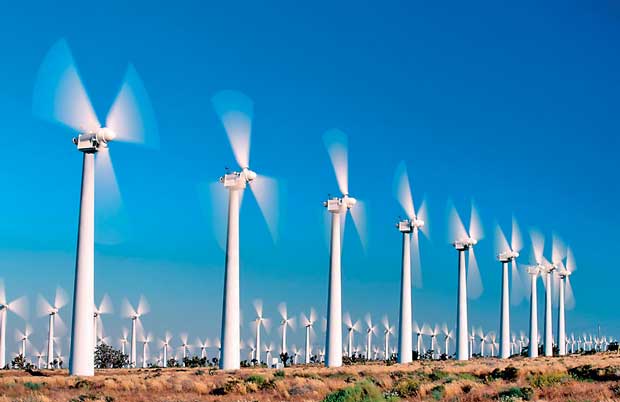29 Mar 2016 - {{hitsCtrl.values.hits}}

By Scott Nyquist
The clean- and safe-energy revolution is not imminent. In fact, according to the information compiled by ‘Looking Ahead: The 50 Global Trends That Matter’, an annual compendium of data and graphics on subjects ranging from economics to demography to energy, the majority of the planet’s electricity needs will still be fueled by coal and natural gas in 2040, despite strong growth in non-hydro renewables such as wind, solar, and geothermal. The report also expects the shale phenomenon to abate, with Saudi Arabia reasserting itself as the world’s leading oil producer in 2030.

Looking Ahead, which is produced by an independent think tank supported by Abu Dhabi’s Crown Prince Court, does not take a view on these trends; instead, it simply lays out the best available information from a wide variety of sources, including governments, consultancies, think tanks, corporations, and multilateral institutions.
The overriding aim of the publication is to highlight issues that matter in compelling visualizations that make it easier for readers to grasp a large amount of interlinked data—and thus better understand both the nature of the problems the world faces and how to address them.
The book details an energy world of disruption and contradiction, mingled with continuity and a dash of hope. For example, as the world again seeks to devise ways and means to curb the greenhouse gas emissions associated with climate change, we find non-hydro renewables could more than triple their share of the global power supply by 2040. And the development of renewables isn’t just a rich-country trend.
Expanding by 4.6% a year
Among the members of the Organisation for Economic Co-operation and Development (OECD), which mostly includes highly developed countries, renewables are expanding by 4.6 percent a year. Among those outside the OECD, the figure is 7.4 percent. In the next 25 years, renewables will account for an estimated 43 percent of Africa’s new power plants, 48 percent of Asia’s, and 63 percent of Latin America’s. Asia alone is projected to add 1,587 renewable-power plants, almost as many as the rest of the world combined.
Here’s the contradiction. Even after that boom in renewables, the sector’s total share of global electricity generation is estimated to be only 17 percent by 2040, because coal (31 percent) and natural gas (24 percent) will continue to be low-cost and reliable sources of power (Exhibit 1).
When it comes to another big fossil fuel—oil—there has been change, but the long-term outlook is more of the same. Preliminary estimates are that the United States has overtaken Saudi Arabia as the world’s largest oil producer, thanks to the gusher of production from shale assets. Indeed, the development of shale has been truly disruptive to world oil markets, contributing to sustained low prices. Yet Looking Ahead believes that history, or at least geology, will reassert itself. By 2030 or 2035, shale production is likely to begin to decline and the Organization of Petroleum Exporting Countries (OPEC) could be back to producing half the world’s oil.
In a world that is not short of problems, it can be easy to overlook success. One positive trend is that more people than ever have access to electricity—about 82 percent of the global population. Since 1990, India has improved access by 25 percentage points, and in China electricity is now close to universal. Unfortunately, Africa will continue to lag behind. About 1.3 billion people today lack electricity, and almost all of them are in South Asia and sub-Saharan Africa. About a billion will still lack ready access in 2030—and sub-Saharan Africans will comprise almost three-quarters of that population. Getting more power to more people isn’t just a matter of convenience, it’s necessary for both economic development and health. People without electricity often burn wood or dung for cooking, which are indoor sources of air pollution that kill more people every year than malaria and tuberculosis combined.
Nuclear fusion
And here is a final example of contradiction and continuity. The contradiction: if curbing greenhouse gas emissions is an urgent priority, why isn’t nuclear-power generation more popular? At the moment, nuclear power is the only zero-emissions way to keep the lights on 24/7, but its share of capacity is projected to stay at 12 percent for the next quarter century. As for continuity: nuclear fusion is still promising. The potential of fusion has always been tantalizing. It could be 20 times more efficient than fission, and the waste created is in the form of nonradioactive helium. In partnership with six other countries, France, which generates more than 75 percent of its power with nuclear, is scheduled to open a demonstration fusion plant in 2019. However, uncertainty still exists about the viability of the technology—which is precisely what has been said since the 1950s.
For the foreseeable future, then, the data contained in Looking Ahead: The 50 Trends that Matter point to a world energy strategy—to the extent that there is one—that will remain “all of the above.” Or, more precisely, more of all of the above. More renewables, and more fossil fuels. More access to power, and more deaths related to lack of access. Lots of American oil, and more OPEC oil. If there is a single thread connecting all these trends, it is that a global energy revolution is not nigh. But an energy evolution is very much under way.
(Scott Nyquist is a director in McKinsey’s Houston office; James Manyika is a director of the McKinsey Global Institute and a director in McKinsey’s San Francisco office)
24 Nov 2024 4 hours ago
24 Nov 2024 7 hours ago
24 Nov 2024 8 hours ago
24 Nov 2024 8 hours ago